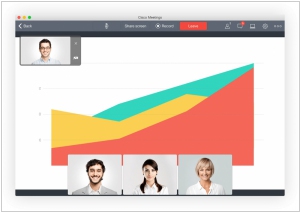Cisco Unified Communications vs Pexip
March 16, 2025 | Author: Adam Levine
12★
With Cisco Unified Communications, your company can connect co-workers, partners, vendors, and customers with the information and expertise they need, access and share video on the desktop, on the road, and on-demand, as easily as making a phone call, facilitate better team interactions, dynamically bringing together individuals, virtual workgroups, and teams, make mobile devices extensions of the corporate network so mobile workers can be productive anywhere
7★
The video technology platform that powers everything from ultra secure government meetings, to personalized banking, to efficient hands-free work.
Cisco Unified Communications and Pexip are both rather clever bits of technology designed to make people talk to each other, which is ironic because most of the time, people spend their meetings trying to avoid actually saying anything meaningful. Both systems allow for video conferencing, voice calls and collaboration, which means you can see your colleagues sigh in real time as another meeting gets scheduled. They also offer interoperability, meaning they can connect to other platforms like Microsoft Teams and Zoom, thereby ensuring that no one can ever escape from an impending conference call. Security and encryption are included, presumably so that no one can hack in and pretend to be your boss, though that would at least make meetings more interesting.
Cisco Unified Communications, being a product of the great American networking empire, has been around since the early 2000s and is built for the sort of enormous corporations that have entire departments dedicated to ensuring their VoIP phones remain precisely where they were last Tuesday. It integrates tightly with Cisco's vast array of networking hardware, meaning if you’ve already invested in a labyrinth of Cisco devices, you might as well continue down the rabbit hole. It's particularly beloved by call centers, government institutions and other organizations where clear, structured communication is theoretically encouraged, though in practice, it’s mostly used to ask whether someone got that email from last week.
Pexip, on the other hand, hails from Norway, a land known for fjords, Northern Lights, and—apparently—secure video conferencing since 2012. It specializes in making different video systems speak to each other, whether they want to or not, by acting as a kind of digital diplomat for incompatible platforms. This makes it particularly useful for military, healthcare and public sector users who absolutely cannot afford for their meetings to turn into an unholy mess of "Can you hear me now?" conversations. While Cisco builds a vast ecosystem of unified communications, Pexip is more like a universal translator, ensuring that everyone, no matter their tech allegiance, can join in on the meeting they didn’t want to attend in the first place.
See also: Top 10 Videoconferencing software
Cisco Unified Communications, being a product of the great American networking empire, has been around since the early 2000s and is built for the sort of enormous corporations that have entire departments dedicated to ensuring their VoIP phones remain precisely where they were last Tuesday. It integrates tightly with Cisco's vast array of networking hardware, meaning if you’ve already invested in a labyrinth of Cisco devices, you might as well continue down the rabbit hole. It's particularly beloved by call centers, government institutions and other organizations where clear, structured communication is theoretically encouraged, though in practice, it’s mostly used to ask whether someone got that email from last week.
Pexip, on the other hand, hails from Norway, a land known for fjords, Northern Lights, and—apparently—secure video conferencing since 2012. It specializes in making different video systems speak to each other, whether they want to or not, by acting as a kind of digital diplomat for incompatible platforms. This makes it particularly useful for military, healthcare and public sector users who absolutely cannot afford for their meetings to turn into an unholy mess of "Can you hear me now?" conversations. While Cisco builds a vast ecosystem of unified communications, Pexip is more like a universal translator, ensuring that everyone, no matter their tech allegiance, can join in on the meeting they didn’t want to attend in the first place.
See also: Top 10 Videoconferencing software





